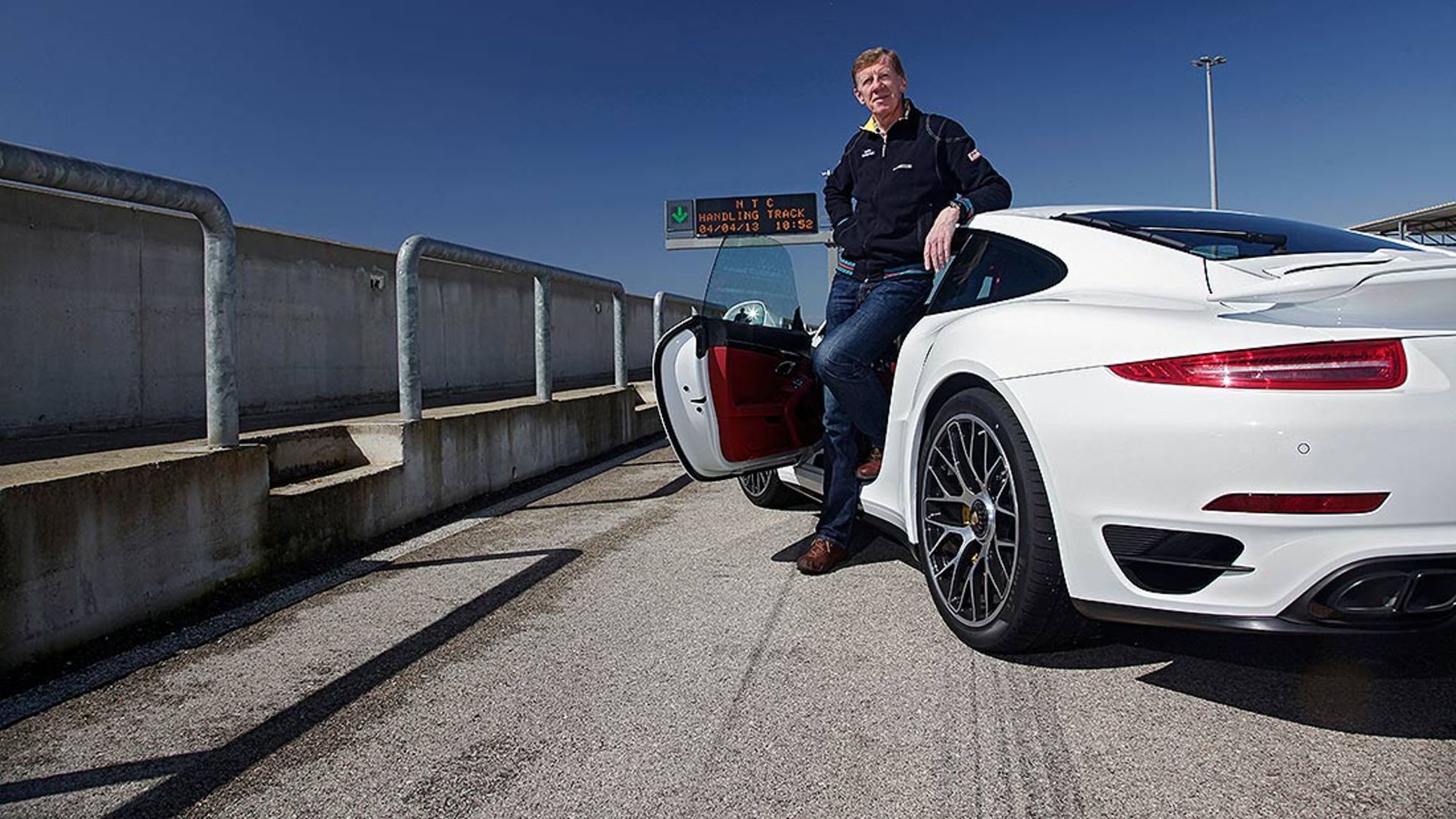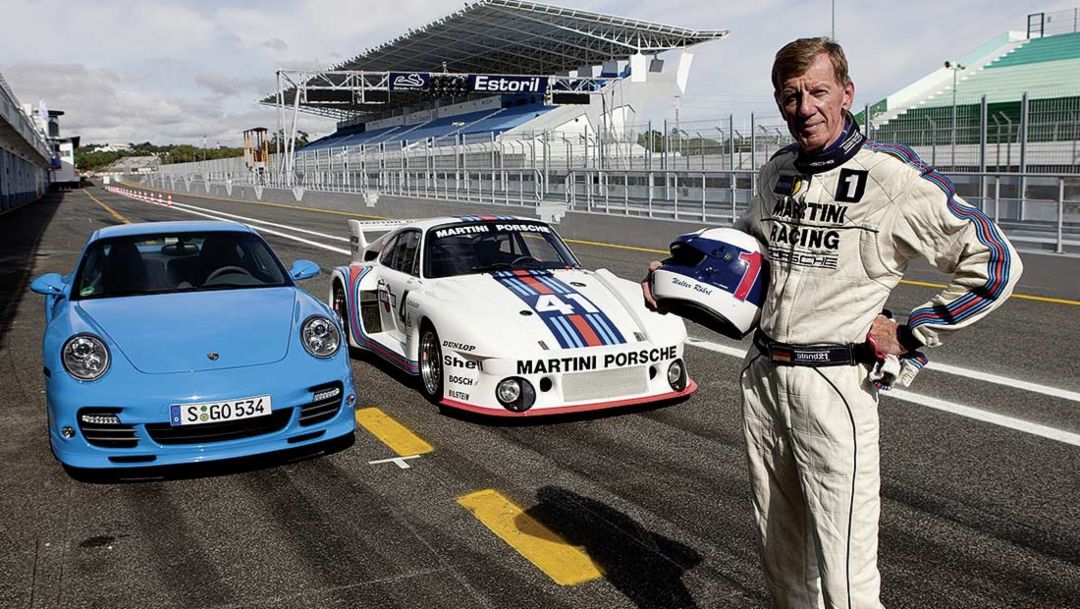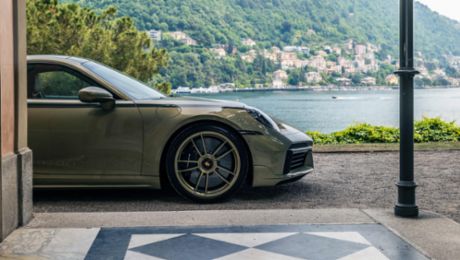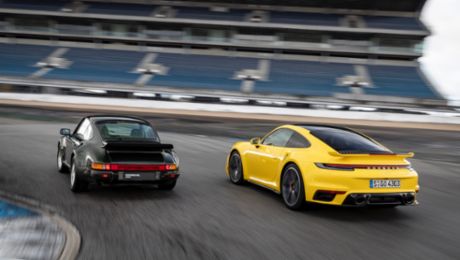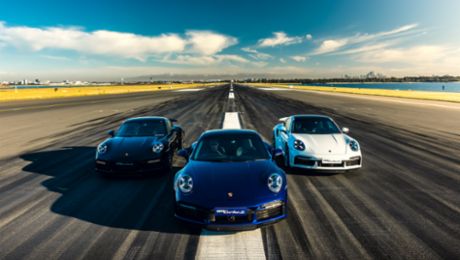The little bird sits on the curb of the handling track, wings tucked, beak in the sun. The new Porsche 911 Turbo S, hurtling out of a fast right bend in search of the perfect line, has the bird right between its headlights. The bird stays put. Perhaps, even here in southern Italy, Walter Röhrl’s reputation as an animal-lover precedes him. Not to mention the fact that the Turbo S has the new rear-axle steering.
Walter smiles as he steers the car toward the bird and into the left bend. In third gear and pushing pretty hard, he calmly says "a sparrow", effortlessly pulls the car to the right, and then immediately regains his line. The car passes the "sparrow test", a contemporary version of the famous “moose test,” with flying colors. The little bird still sits on the curb, spreads its wings into the wind, and confirms the theories of the technicians at Porsche’s Weissach Development Center with a flurry of excited chirping.
If there’s a race car in every Porsche, the Turbo has nevertheless been in a class of its own for 39 years. Lightweight construction, boost-pressure control, charge-air cooling, double-clutch transmission, ceramic brake system, wheels with central locking, and active all-wheel drive were all originally developed for motor racing, and burnished their case for use in road-going sports cars with each successive victory on the track. The new 911 Turbo and TurboS take this principle to even greater extremes. Indeed, the active aerodynamics and rear-axle steering have become so sophisticated that they’ve outpaced current motor-racing regulations.
With 412 kW (560 hp, combined fuel consumption 12.4 – 8.2 l/100 km; CO₂ emissions 289 – 194 g/km) under the hood, the Turbo S packs racing-caliber power. The maximum torque of 750 Nm in overboost mode cuts across the speed diagram like a graphic mesa. And its average fuel consumption, measured at 24.2 mpg in Europe, still being certified in the United States, is also unparalleled among the ranks of super sports cars. For Wolfgang Hatz, the board member for Research and Development at Porsche, the collected talents of the 911 Turbo and Turbo S embody the spirit of the Porsche brand perfectly. “We develop our series models on the racetrack.” Erhard Mössle, the man who heads up the all-wheel-drive faction in the 911 Carrera series, explains that the racetrack is precisely where the classic dichotomy between improved performance and lower fuel consumption is especially tricky to resolve. “And that’s how we manage to put out the best Turbo of all time with each new generation.” Wolfgang Hatz, himself no stranger to race-tempo test-drives, goes into detail: “In the new Turbo, the steering is another 10 percent more direct than in the 991 Carrera because the rear-axle steering provides additional lateral support.”
No one sums up the overall effect better than Walter Röhrl. The two-time world rally champion has been at the heart of fine-tuning series developments over the past twenty years at Porsche. As for the steering, Röhrl says, quite simply, “It makes everything easier, and yields the greatest benefits in S-curves.”
The handling track at the Nardò Technical Center is a rather theatrical composition consisting of S-bends of varying curve radii and speeds. The sweeping left curve at the end of the long straightaway comes to a rather abrupt conclusion, and all of a sudden the fireworks are in full swing: left–right–sparrow–left until the track crests and the Turbo S gently springs out of its compression to catch a glimpse of the pastel-blue waters of the Gulf of Taranto. The astonished driver who rubs his eyes in amazement will miss the braking point for a tight left turn at the end of the crest and power into a generous run-off zone consisting entirely of bushes. Behind that is the beach. Walter Röhrl is not in the mood for sunbathing.
Almost nonchalantly he maneuvers the white Turbo S through the curve. With no sparrows in the way, the chassis absorbs the curbs with a light-footed elegance. When Walter steers only with his left hand, he can focus all the more intently on underscoring his explanations with his right. “I bought a used 356 over forty years ago because it was always important for me as a race-car driver that with a Porsche you had to change only 20 percent of the parts to convert a road car into a winning race car. With the competitors, it was 80 percent.”
In the evolution of the Turbo “from an idiosyncratic sports car into my favorite Porsche,” Walter Röhrl sees a microcosm of the development of the brand as a whole. “Racetracks are the toughest proving grounds. Everything has to be right—the comfort of the seats, fuel consumption, wind noise—and at the end of a lap, the stopwatch pronounces its judgment.” At the end of the long straightaway, cruising along in sixth gear at 172 mph, Walter Röhrl senses an ideal opportunity to elaborate: “The Turbo is very easy to drive. It even handles approaches to second-gear curves very nicely—a real advantage of the rear-axle steering. It really is amazing how calmly and safely even normal drivers can now drive around with 560 hp at their disposal.”
Ideas like moderate steering of the rear wheels and active aerodynamics with the front spoiler and rear wing are rooted in the motor-racing philosophy of all Porsche engineers. Steering the rear wheels at angles of up to three degrees enables something like the squaring of the circle in terms of driving dynamics. Opposite-direction steering at up to 31 mph corresponds to a virtual shortening of the wheelbase by around 9.8 inches, while same-direction steering over about 50 mph virtually extends the wheelbase by a stately 19.6 inches. In short: improved agility and better driving stability at once. Or as Erhard Mössle puts it succinctly, “The new Turbo proves once again that we resolve contradictions.”
For example, through active aerodynamics. Normally the factors “low wind resistance” and “aerodynamic downforce” are regarded as mutually exclusive. In the new Porsche 911 Turbo/Turbo S, the contradiction is resolved through the combination of a multiposition front spoiler made of flexible plastic and a multiposition split wing in the rear. With three speed-sensitive positions each, the resulting choreography of components offers everything from ample ground clearance in front (departure angle) to low fuel consumption and aerodynamic downforce on the front and rear axles.
In the standard position, both the front spoiler and rear wing are retracted, increasing the distance between the road and the middle of the spoiler by 0.78 inches compared to its predecessor. In Speed mode, the front spoiler is partially extended, while the upper half of the split wing rises by 0.87 inches. In Performance mode, a fully extended front spoiler and a split wing extended 2.76 inches upwards and tilted forwards by seven degrees generate aerodynamic downforce on both axles.
Walter Röhrl personifies the unabashed art of achieving “the best of both worlds” like no one else. He is both a speed-demon par excellence and a Porsche-whisperer of surpassing sensitivity. When a mosquito hits the windshield, Röhrl feels the pain of the insect and the glass in equal measure. In spite of his exceptional knack for posting best times on the track, he appreciates the 911 Turbo’s qualities in another discipline as well: “Show me another super sports car that can boast an even remotely similar degree of everyday comfort. The seats, air-conditioning, infotainment, storage spaces—it’s all top-notch, as ideally suited to a run to the bakery as to the track.”
To exceed even the demanding standards of Walter Röhrl, the 911 Turbo has matured into a masterpiece with many variables. Variable chassis, Sport Chrono package with dynamic engine operating cycles, rolling-motion compensation (Porsche Dynamic Chassis Control, PDCC), and Torque Vectoring Plus, including electronically controlled rear-axle differential lock, combine to form the ultimate active super sports car. Research and Development board member Wolfgang Hatz states simply, “We feel validated when others assume that we must have an active chassis.”
Not to mention an active environmental component: the Porsche Turbo and TurboS already fulfill the Euro 6 emissions standard that will come into effect in September 2015. The sparrow on the curb can continue to breathe easy.
Info
Text first published in the Porsche customer magazine Christophorus, no. 362
Consumption data
911 (Type 991): Combined fuel consumption: 9.0 – 8.2 l/100 km; CO₂ emission: 211 – 191 g/km
911 Turbo: Combined fuel consumption: 9.7 l/100 km; CO₂ emission: 227 g/km
911 Turbo S: Combined fuel consumption: 9.7 l/100 km; CO₂ emission: 227 g/km
